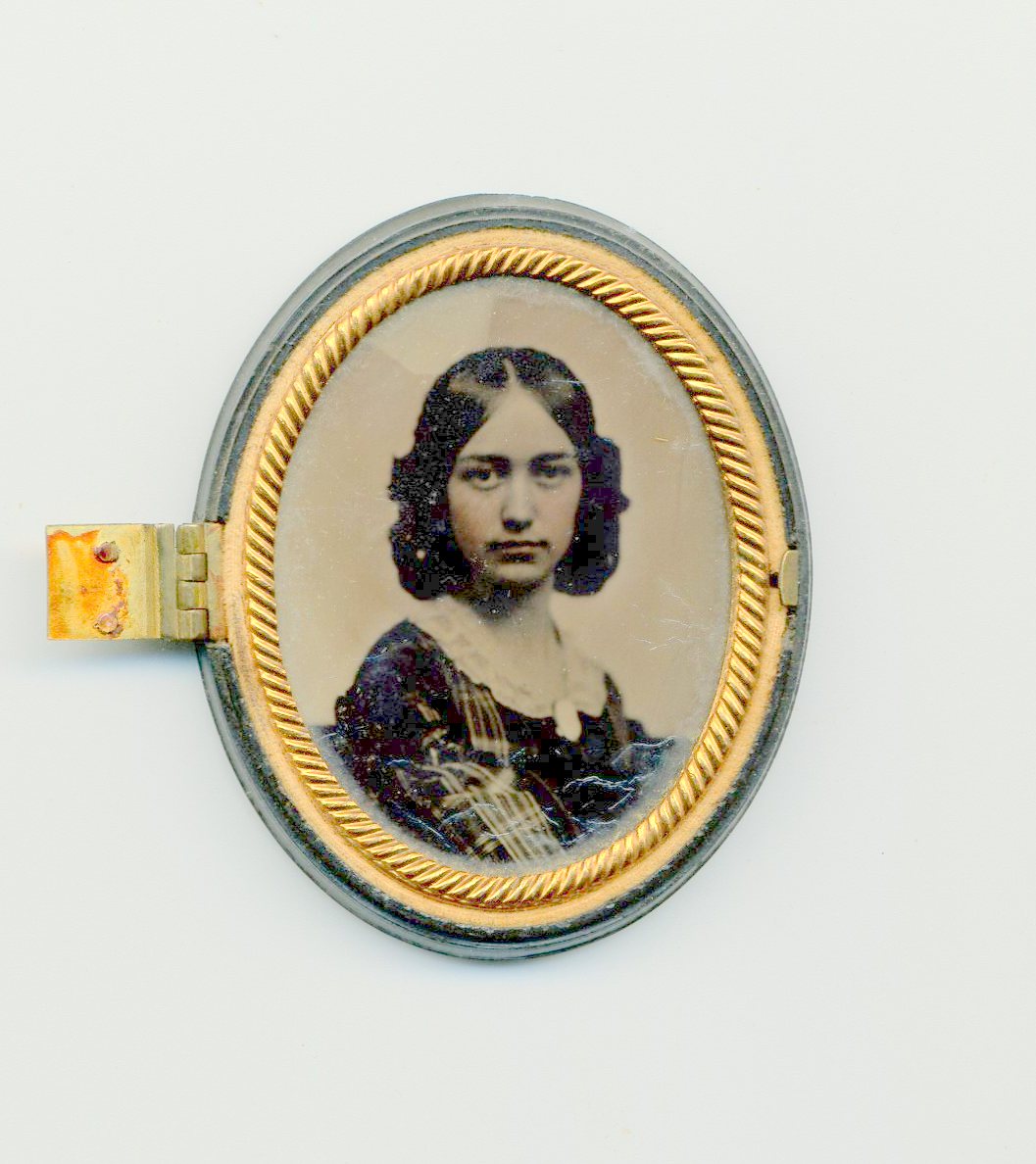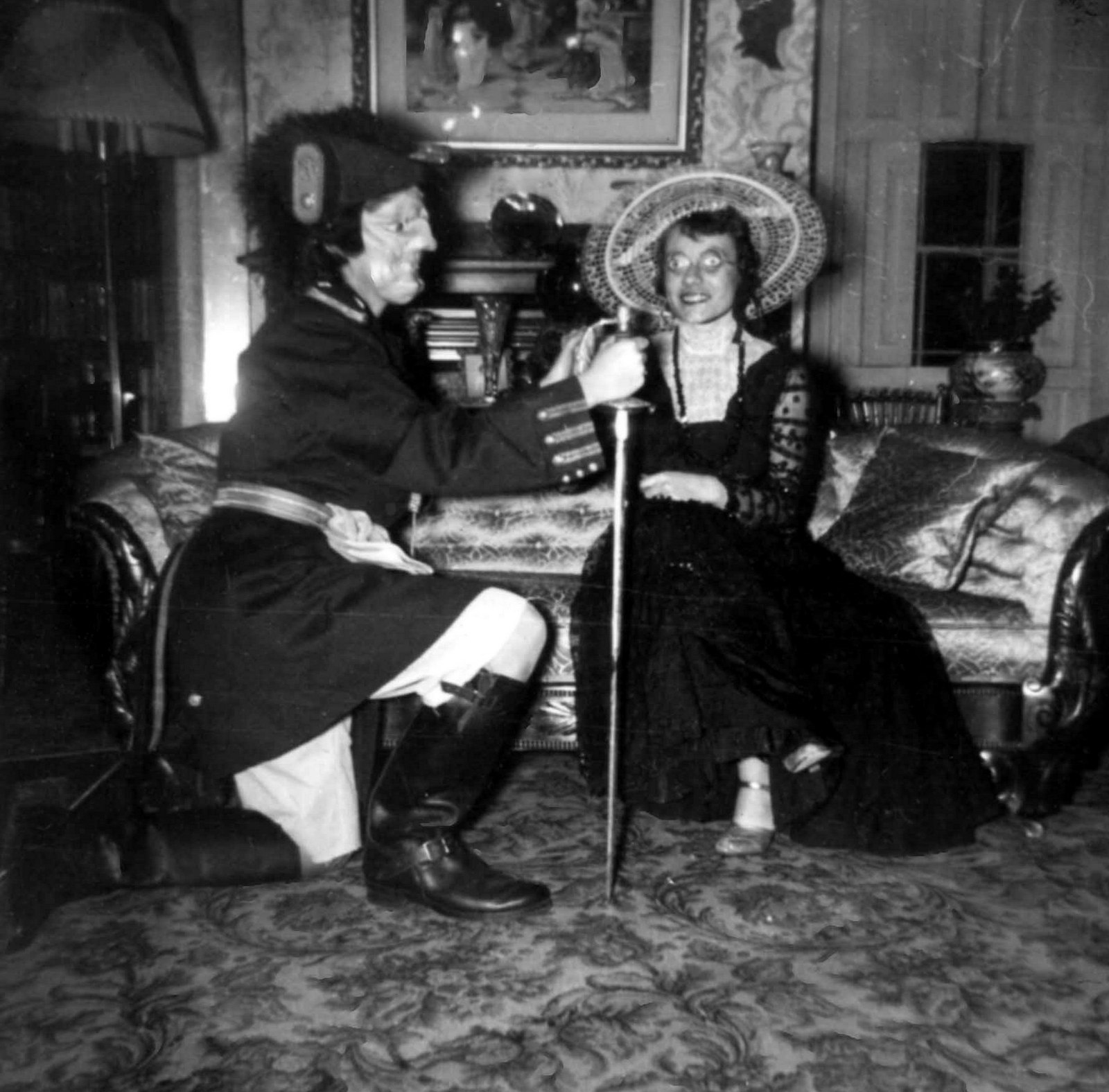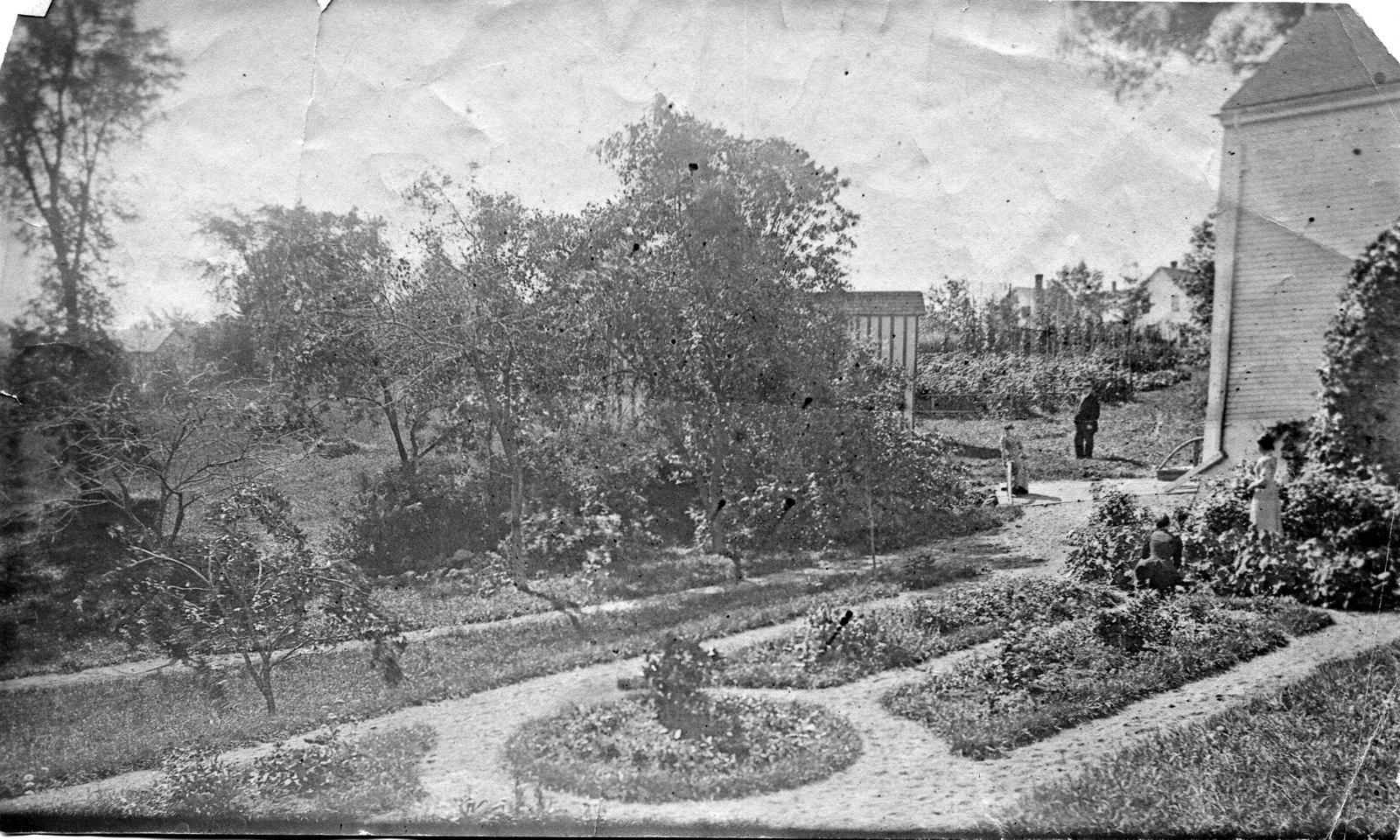By Jerry LaPointe
[See Dr. Swan House, part 1]
In 1908, when Dr. Swan died, Minerva Swan’s son, Ralph Horton, and his growing family lived in the house across the street which had been built for him and his bride in 1898. Mrs. Swan continued with her civic duties, one of which was playing the organ at the Congregational Church which she did for many years, as well as playing for Calais Academy graduations, which were held in the church until the building of the State Theater. We hope you enjoy reading about life with Mrs. Swan, her son and his family until they finally left the Swan house in 1970.

Minerva Swan at 19 in 1861- Matriarch of the family
Following the death of Dr. Swan, it is believed that life went on as it must in all households when a loved one is gone. Grandmother Swan, as she came to be known by her five grandchildren, continued to live in her grand residence, and the young family across the street continued to live in their very pleasant and large Queen Anne house, growing as all families do and going back and forth between their own home and Grandmother’s. However, sometime around 1918, their fortunes changed. At that time a mink farm had been started on South Street. There had also been one in St. Stephen. These mink farms were profitable and it seemed, as such things often do, to be an opportunity not to be missed. And so, it was decided, probably by Ralph Horton and his mother, that the family fortunes should be invested in this “sure to get rich” opportunity. Perhaps the family money was running out after a decade without Dr. Swan or perhaps, as is so often the case, a chance to make money quickly just could not be resisted. Probably no one will ever know the logic behind the decision, but the decision was made and the money was invested. Unfortunately, the winter was unusually harsh, the mink became sick and died, and the money was lost. This changed everything. It became necessary for Ralph Horton to sell the house across the street which had been built as a wedding present for him and his young bride and, in order to save the family homestead, move with his large family into his mother’s house. From that time on Grandmother Swan, her son, her daughter-in-law, and her five grandchildren all lived together in what would become the Swan-Horton house. However, despite the circumstances, it is believed these were not unhappy times and the Horton children grew up with happy memories of life with Grandmother on “Swan Farm”. Clearly, it would seem, they “made the best of things”.

Tom Horton, sitting second from left, at Yellowstone
Although the loss of the family fortunes caused certain hardships, Grandmother Swan somehow managed to provide her grandson, Tom, with a trip to California. When Tom would have been a senior at Calais Academy, Grandmother Swan took him out of school for a year causing him to graduate one year later than he would have had he remained in school. During this year they traveled to Yosemite National Park, Sacramento and other places in California. They stayed at hotels and ranches, and visited relatives, including Dunning and Marion Rideout, Grandmother’s nephew and his wife. Dunn, as he was known, had left Calais to go to work in his uncle’s bank in California many years before. The Rideout Bank eventually came under Dunn’s control and it was he who transformed it into what we know as the Bank of America. The trip was an exciting adventure for Tom, probably just as his grandmother intended it should be. Parties and dances were given in his honor to introduce him to other young people, his picture was taken standing in the root of a redwood tree and perched high on a rock with El Capitan in the background. It was an experience he remembered vividly for the rest of his life and the scrapbook he created during this trip has survived. Where the money came from for this trip is not known, especially considering the failure of the mink farm, but somehow Grandmother Swan managed to provide this last expression of wealth to her grandson.

Ralph Horton Coal Company Hog Alley-the library can be seen between the buildings
Despite their reduced circumstances, which were never again to be reversed, the family managed to maintain the property with pride. For all the years of their ownership, from the house’s building in 1835 until it was sold in 1971, the family pooled their resources, each one contributing what they could, as they could, if they could. Maintaining the house as “it had always been” and at all any sacrifice necessary, was the collective goal. The house, its furnishings and other belongings, and its traditions were safeguarded in the manner of “Grandmother’s day”. During the first years of their reversed fortunes, Ralph continued to work and support the family. He ran a coal business started by his uncle, George King, which he carried on after his uncle’s death. Like his grandfather before him, he was elected Mayor of Calais and served two terms in this position. In 1923 he was appointed postmaster and was still in that post when he died in 1935. Upon his death the Advertiser reported:
It began with. . . .A hush of sadness fell over our city when it was known that in the early hours of Friday morning he had passed to the “Home Beyond”. . . . .and continued. . . .To few is it given to live an entire life in our community and be able to make such loyal friends in all walks of life, that throughout the entire city his loss is felt as a personal one. Can we say his life that has meant so much to so many people has not been lived to the full, though in years it was shorter than the allotted span?
At this time another adjustment had to be made within the family. Young Tom had married Pauline Harrington a few years prior to his father’s death. Polly, as she was known, owned a small house on Elm Street which had belonged to her mother before she died and, being an only child, was left to her. She and Tom lived happily in their own home; however, with the death of Ralph Horton, it fell upon Tom to become the major contributor to the support of the family.

Horton teenagers-Swan Street 1925
Grandmother Swan had died in 1933 at the age of 91 but Tom’s mother, Nellie Horton, and three of his sisters were still living at home. Tom and Polly decided it was their duty to sell Polly’s house, which she loved, and moved to the big house on Swan Street. It was the only way the house could be saved, much as it had been the only way to save the house when his father sold the Queen Anne house on Swan Street over twenty years earlier. Once again the family was reshuffled and the household now contained Tom, Polly, Nellie, Eleanor, Harriet, and Marion. Eleanor was only to live another few years, dying in her 30s, the result of a heart condition. Eleanor had been born a “blue baby” and though she taught school away from home for a few years, her fragile health made her give up this position and return home to work as a bookkeeper at the Citizen Gas Company in Calais until her death. Both Tom and Polly, having no children, worked all their lives to support life at “Swan Farm”.
In the 1920s, despite prosperous times in the nation, the family looked for ways to reduce costs. After all, they had a large house to maintain and eight family members to feed and clothe. Seeking a reduction in their property taxes they were told by the city that if they removed the handsome two-story carriage house that was attached to the right of the back of the house and which extended towards Barker Street, their taxes would be less. It was a hard decision to raze this structure because it was in good condition, it provided useful storage, and the upper floor had been used by the children as a playroom. They had often put on plays for neighborhood children on a stage they had created at one end of the upstairs. However, it was decided to tear it down to save money and, to the great chagrin of the family for decades, their tax bill was only reduced by $20. They never stopped telling this story.
Education was important to the family and so the Horton children were given as much an opportunity to attend college as was possible. Eleanor, Harriet, and Marion attended Washington State Normal School and all taught school. Eleanor for only a short time, Marion for several years, and Harriet for many years as a fourth-grade teacher in the Calais schools. She married Bill LaCroix and lived in a house on Hinckley Hill, having two daughters, Eleanor and Jane. Jane also taught in Calais for several years before moving to Brunswick. Both of Harriet’s daughters are now deceased. Alice became a dental hygienist and married twice, both times to dentists. Her first husband was Dr. McTague who practiced here in Calais and they had one son, Tom McTague, who is also deceased. Her second husband was Dr. Fred Savage who had come from Eastport. They lived most of their married lives in Orono.

Marion also taught briefly at the new Calais Memorial High School
Marion had what may be considered a more interesting life. After finishing her education to become a teacher she took a job in Houlton. There she boarded with Judge Madigan and his family. The Madigans were related to the Cunningham family who lived in a four-story townhouse located at number 43 Chestnut Street on Beacon Hill in Boston. Mr. Cunningham was a lawyer in Boston and served as the lawyer for the arch-diocese. They were wealthy and lived comfortably in their Beacon Hill residence. From time to time they visited their Madigan relatives in Houlton and it was here that Marion met their son, Henry Cunningham. Henry was many years older than Marion but they were married and Marion began a life living between Calais and Boston. In the winter she spent most of her time living in the Cunningham family home on Chestnut Street pursuing interest in Boston, and in the summer she spent much of her time in Calais. She was very civic minded, she sometimes substituted in the schools, frequently rode her bicycle around town, served on the board of directors at the library, and was one of the founders of the St. Croix Historical Society. She wrote articles about local history and was completely devoted to the preservation of the old family home on Swan Street. When Henry died she inherited a good deal of money and spent more and more time at home in Calais. In 1964 she went on a tour of Europe and met a man from Racine, Wisconsin named Fred Beere. In November of that year they were married at the house on Swan Street and immediately flew to Wisconsin where she began to set up housekeeping in her new home on the shores of the lake. However, tragedy was soon to strike. In February 1965, Marion developed appendicitis, which burst before she could be saved. What started as a new life with a new husband in a new home, ended with her death. The money she had inherited from Henry Cunningham went to her new husband; however, when he died he left the remaining money to Marion’s surviving sisters and to her sister-in-law, Polly.

Betty Barnes and Maion Horton at Swan House party 1950
During the near century and a half the Swans and the Hortons owned this grand old house, it was the site of much fun and laughter and of many grand parties and many more simple occasions. It was a favorite story of the family to tell how old Mrs. Horton insisted upon maintaining an aura of position, long past the time when there was any money to support this. At dinner parties she would always say to her guests, “Oh please, do have some more”, and the family members would hold their breath because they knew they had scaped every pot to provide the meal that had now been eaten and there was no more! It was a custom for the matriarchs of old Calais families to have luncheons in the dining room of the old St. Croix Hotel; however, they always brought their own china and tableware, carefully wrapped and bundled and transported. Mrs. Horton also indulged in this tradition. She made donuts to sell in Jane Todd’s lunchroom. Each week Jane Todd’s grandsons, Alfred Burgermeister and one or more of his brothers, Kippy and Todd, would pick them up from Mrs. Horton’s kitchen and deliver them to their grandmother. At various times, the family sold off house lots from the large original plot of land – one just below the house on Swan Street, three on Washington Street, and two more on Barker Street. As time went on, their existence in the old house became easier to support. The daughters married and established their own households, the number of people to be supported dwindled down to just Tom, Polly and old Mrs. Horton, and then to just Tom and Polly. Marion’s circumstances made her able to comfortably help the family if needed and they went on living in their grand old house. In the winter, when it was cold and heating bills were high, they had an upstairs parlor and, with the exception of Christmas or some other special occasion, they closed off the large double front parlor during the coldest months. Yet, through it all, they remained vigilant vanguards of their family home.

The Swan house gardens were spectacular

…as were the grounds generally. Washington Street is to the top of the photo, just beyond the trees.
When Tom Horton died in 1969 the house was left jointly to his wife, Polly, and to his two remaining sisters, Alice Horton Savage and Harriet Horton LaCroix. His sisters had their own homes, and the house was really too big for Polly to maintain on her own, so it was decided the time had come to sell the house and auction its contents. Each of the three surviving members of the family was free to select any items they wished to keep, which they did. Everything else was auctioned on the front lawn of the house in August of 1970. Before the auction, Polly carefully photographed precious items and searched throughout the house for over a year to ensure she was saving anything important to the family, while also furnishing her new four room apartment on North Street. On the day of the auction, she was emotionally unable to attend, and spent the day quietly in her new apartment, sobbing when anyone came to see how she was doing. What now survives of the contents of this remarkable house which had been the repository for four generations of Swans and Hortons, is primarily those items selected by Polly when she left the house. There were many remarkable items, however, that were not saved and which were sold at the auction. At the time of the auction the contents of the house included a uniform and sword from the War of 1812, a letter from Hannah Weston, a Sheraton sideboard, a John Warren Moore secretary that had belonged to Gilman D. King and which still contains the label bearing his name, a mahogany cradle, pewter, the presentation pieces given to Dr. Swan, amethyst vases, many Victorian pieces, and the list could go on and on. The auction was well advertised and antique dealers came from across New England and beyond and most of the contents of the house were dispersed far and wide. After nearly 140 years the house was empty.
The history and legacy of the Dr. Swan house lives on. There is a collection of items from the house that remains in Calais and the historical society has copies of pictures showing both the exterior and interior of the house, some from the 1890s. The old pump on the back porch, which at the time the house was sold was the last remaining working water pump left in Calais, is now gone. Alterations have been made and windows replaced. The chimneys have been removed and the fireplaces can no longer burn wood. But the house remains, in good condition, well-loved and well-maintained. No longer are Mrs. Horton’s George Washington’s birthday breakfasts served at the dining room table on February 22nd each year, complete with cherry tarts for dessert, but the grandeur and the graciousness of this house live on, and the story of its inhabitants continues to be told.
